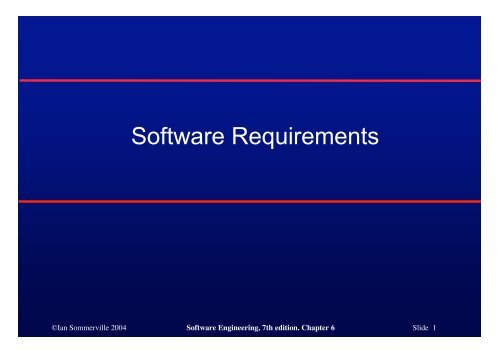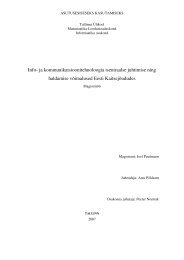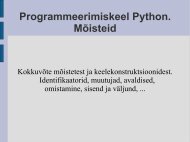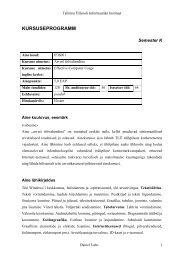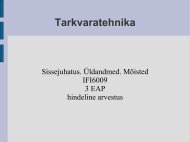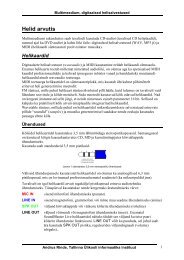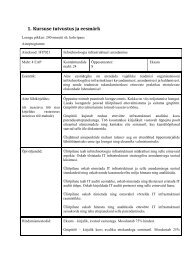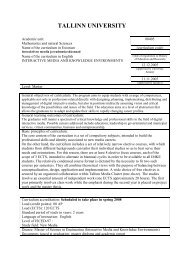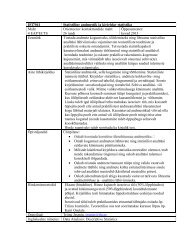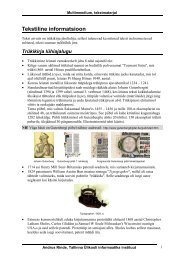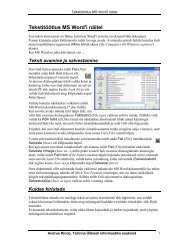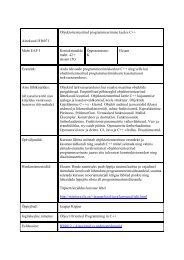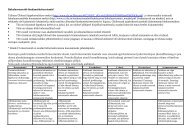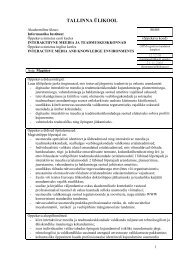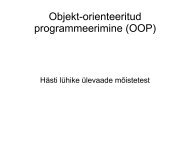Software Requirements - Ian Sommerville
Software Requirements - Ian Sommerville
Software Requirements - Ian Sommerville
Create successful ePaper yourself
Turn your PDF publications into a flip-book with our unique Google optimized e-Paper software.
<strong>Software</strong> <strong>Requirements</strong>©<strong>Ian</strong> <strong>Sommerville</strong> 2004 <strong>Software</strong> Engineering, 7th edition. Chapter 6 Slide 1
Objectives●●●To introduce the concepts of user and systemrequirementsTo describe functional and non-functionalrequirementsTo explain how software requirements may beorganised in a requirements document©<strong>Ian</strong> <strong>Sommerville</strong> 2004 <strong>Software</strong> Engineering, 7th edition. Chapter 6 Slide 2
Topics covered●●●●●Functional and non-functional requirementsUser requirementsSystem requirementsInterface specificationThe software requirements document©<strong>Ian</strong> <strong>Sommerville</strong> 2004 <strong>Software</strong> Engineering, 7th edition. Chapter 6 Slide 3
<strong>Requirements</strong> engineering●●The process of establishing the services that thecustomer requires from a system and theconstraints under which it operates and isdeveloped.The requirements themselves are thedescriptions of the system services andconstraints that are generated during therequirements engineering process.©<strong>Ian</strong> <strong>Sommerville</strong> 2004 <strong>Software</strong> Engineering, 7th edition. Chapter 6 Slide 4
What is a requirement?●●It may range from a high-level abstract statementof a service or of a system constraint to adetailed mathematical functional specification.This is inevitable as requirements may serve adual function• May be the basis for a bid for a contract - thereforemust be open to interpretation;• May be the basis for the contract itself - thereforemust be defined in detail;• Both these statements may be called requirements.©<strong>Ian</strong> <strong>Sommerville</strong> 2004 <strong>Software</strong> Engineering, 7th edition. Chapter 6 Slide 5
<strong>Requirements</strong> abstraction (Davis)“If a company wishes to let a contract for a large software development project, itmust define its needs in a sufficiently abstract way that a solution is not pre-defined.The requirements must be written so that several contractors can bid for the contract,offering, perhaps, different ways of meeting the client organisation’s needs. Once acontract has been awarded, the contractor must write a system definition for the clientin more detail so that the client understands and can validate what the software willdo. Both of these documents may be called the requirements document for thesystem.”©<strong>Ian</strong> <strong>Sommerville</strong> 2004 <strong>Software</strong> Engineering, 7th edition. Chapter 6 Slide 6
Types of requirement●●User requirements• Statements in natural language plus diagrams of theservices the system provides and its operationalconstraints. Written for customers.System requirements• A structured document setting out detaileddescriptions of the system’s functions, services andoperational constraints. Defines what should beimplemented so may be part of a contract betweenclient and contractor.©<strong>Ian</strong> <strong>Sommerville</strong> 2004 <strong>Software</strong> Engineering, 7th edition. Chapter 6 Slide 7
Definitions and specifications©<strong>Ian</strong> <strong>Sommerville</strong> 2004 <strong>Software</strong> Engineering, 7th edition. Chapter 6 Slide 8
<strong>Requirements</strong> readers©<strong>Ian</strong> <strong>Sommerville</strong> 2004 <strong>Software</strong> Engineering, 7th edition. Chapter 6 Slide 9
Functional and non-functional requirements●●●Functional requirements• Statements of services the system should provide, how thesystem should react to particular inputs and how the systemshould behave in particular situations.Non-functional requirements• constraints on the services or functions offered by the systemsuch as timing constraints, constraints on the developmentprocess, standards, etc.Domain requirements• <strong>Requirements</strong> that come from the application domain of thesystem and that reflect characteristics of that domain.©<strong>Ian</strong> <strong>Sommerville</strong> 2004 <strong>Software</strong> Engineering, 7th edition. Chapter 6 Slide 10
Functional requirements●●●Describe functionality or system services.Depend on the type of software, expected usersand the type of system where the software isused.Functional user requirements may be high-levelstatements of what the system should do butfunctional system requirements should describethe system services in detail.©<strong>Ian</strong> <strong>Sommerville</strong> 2004 <strong>Software</strong> Engineering, 7th edition. Chapter 6 Slide 11
The LIBSYS system●●A library system that provides a single interfaceto a number of databases of articles in differentlibraries.Users can search for, download and print thesearticles for personal study.©<strong>Ian</strong> <strong>Sommerville</strong> 2004 <strong>Software</strong> Engineering, 7th edition. Chapter 6 Slide 12
Examples of functional requirements●●●The user shall be able to search either all of theinitial set of databases or select a subset from it.The system shall provide appropriate viewers forthe user to read documents in the documentstore.Every order shall be allocated a unique identifier(ORDER_ID) which the user shall be able tocopy to the account’s permanent storage area.©<strong>Ian</strong> <strong>Sommerville</strong> 2004 <strong>Software</strong> Engineering, 7th edition. Chapter 6 Slide 13
<strong>Requirements</strong> imprecision●●●Problems arise when requirements are notprecisely stated.Ambiguous requirements may be interpreted indifferent ways by developers and users.Consider the term ‘appropriate viewers’• User intention - special purpose viewer for eachdifferent document type;• Developer interpretation - Provide a text viewer thatshows the contents of the document.©<strong>Ian</strong> <strong>Sommerville</strong> 2004 <strong>Software</strong> Engineering, 7th edition. Chapter 6 Slide 14
<strong>Requirements</strong> completeness and consistency●●●●In principle, requirements should be both complete andconsistent.Complete• They should include descriptions of all facilitiesrequired.Consistent• There should be no conflicts or contradictions in thedescriptions of the system facilities.In practice, it is impossible to produce a complete andconsistent requirements document.©<strong>Ian</strong> <strong>Sommerville</strong> 2004 <strong>Software</strong> Engineering, 7th edition. Chapter 6 Slide 15
Non-functional requirements●●●These define system properties and constraintse.g. reliability, response time and storagerequirements. Constraints are I/O devicecapability, system representations, etc.Process requirements may also be specifiedmandating a particular CASE system,programming language or development method.Non-functional requirements may be more criticalthan functional requirements. If these are notmet, the system is useless.©<strong>Ian</strong> <strong>Sommerville</strong> 2004 <strong>Software</strong> Engineering, 7th edition. Chapter 6 Slide 16
Non-functional classifications●●●Product requirements• <strong>Requirements</strong> which specify that the delivered product mustbehave in a particular way e.g. execution speed, reliability, etc.Organisational requirements• <strong>Requirements</strong> which are a consequence of organisationalpolicies and procedures e.g. process standards used,implementation requirements, etc.External requirements• <strong>Requirements</strong> which arise from factors which are external to thesystem and its development process e.g. interoperabilityrequirements, legislative requirements, etc.©<strong>Ian</strong> <strong>Sommerville</strong> 2004 <strong>Software</strong> Engineering, 7th edition. Chapter 6 Slide 17
Non-functional requirement types©<strong>Ian</strong> <strong>Sommerville</strong> 2004 <strong>Software</strong> Engineering, 7th edition. Chapter 6 Slide 18
Non-functional requirements examples●●●Product requirement8.1 The user interface for LIBSYS shall be implemented as simple HTMLwithout frames or Java applets.Organisational requirement9.3.2 The system development process and deliverable documents shallconform to the process and deliverables defined in XYZCo-SP-STAN-95.External requirement7.6.5 The system shall not disclose any personal information aboutcustomers apart from their name and reference number to theoperators of the system.©<strong>Ian</strong> <strong>Sommerville</strong> 2004 <strong>Software</strong> Engineering, 7th edition. Chapter 6 Slide 19
Goals and requirements●●●●Non-functional requirements may be very difficult to stateprecisely and imprecise requirements may be difficult toverify.Goal• A general intention of the user such as ease of use.Verifiable non-functional requirement• A statement using some measure that can be objectivelytested.Goals are helpful to developers as they convey theintentions of the system users.©<strong>Ian</strong> <strong>Sommerville</strong> 2004 <strong>Software</strong> Engineering, 7th edition. Chapter 6 Slide 20
Examples●●A system goal• The system should be easy to use by experienced controllersand should be organised in such a way that user errors areminimised.A verifiable non-functional requirement• Experienced controllers shall be able to use all the systemfunctions after a total of two hours training. After this training,the average number of errors made by experienced users shallnot exceed two per day.©<strong>Ian</strong> <strong>Sommerville</strong> 2004 <strong>Software</strong> Engineering, 7th edition. Chapter 6 Slide 21
<strong>Requirements</strong> measuresPropertySpeedSizeEase of useReliabilityRobustnessPortabilityMeasureProcessed transactions/secondUser/Event response timeScreen refresh timeM BytesNumber of ROM chipsTraining timeNumber of help framesMean time to failureProbability of unavailabilityRate of failure occurrenceAvailabilityTime to restart after failurePercentage of events causing failureProbability of data corruption on failurePercentage of target dependent statementsNumber of target systems©<strong>Ian</strong> <strong>Sommerville</strong> 2004 <strong>Software</strong> Engineering, 7th edition. Chapter 6 Slide 22
<strong>Requirements</strong> interaction●●Conflicts between different non-functionalrequirements are common in complex systems.Spacecraft system• To minimise weight, the number of separate chips inthe system should be minimised.• To minimise power consumption, lower power chipsshould be used.• However, using low power chips may mean thatmore chips have to be used. Which is the mostcritical requirement?©<strong>Ian</strong> <strong>Sommerville</strong> 2004 <strong>Software</strong> Engineering, 7th edition. Chapter 6 Slide 23
Domain requirements●●●Derived from the application domain anddescribe system characteristics and features thatreflect the domain.Domain requirements be new functionalrequirements, constraints on existingrequirements or define specific computations.If domain requirements are not satisfied, thesystem may be unworkable.©<strong>Ian</strong> <strong>Sommerville</strong> 2004 <strong>Software</strong> Engineering, 7th edition. Chapter 6 Slide 24
Library system domain requirements●There shall be a standard user interface to alldatabases which shall be based on the Z39.50standard.● Because of copyright restrictions, somedocuments must be deleted immediately onarrival. Depending on the user’s requirements,these documents will either be printed locally onthe system server for manually forwarding to theuser or routed to a network printer.©<strong>Ian</strong> <strong>Sommerville</strong> 2004 <strong>Software</strong> Engineering, 7th edition. Chapter 6 Slide 25
Train protection system●The deceleration of the train shall be computedas:• D train = D control + D gradientwhere D gradient is 9.81ms 2 * compensatedgradient/alpha and where the values of 9.81ms 2/alpha are known for different types of train.©<strong>Ian</strong> <strong>Sommerville</strong> 2004 <strong>Software</strong> Engineering, 7th edition. Chapter 6 Slide 26
Domain requirements problems●●Understandability• <strong>Requirements</strong> are expressed in the language of theapplication domain;• This is often not understood by software engineersdeveloping the system.Implicitness• Domain specialists understand the area so well thatthey do not think of making the domain requirementsexplicit.©<strong>Ian</strong> <strong>Sommerville</strong> 2004 <strong>Software</strong> Engineering, 7th edition. Chapter 6 Slide 27
User requirements●●Should describe functional and non-functionalrequirements in such a way that they areunderstandable by system users who don’t havedetailed technical knowledge.User requirements are defined using naturallanguage, tables and diagrams as these can beunderstood by all users.©<strong>Ian</strong> <strong>Sommerville</strong> 2004 <strong>Software</strong> Engineering, 7th edition. Chapter 6 Slide 28
Problems with natural language●●●Lack of clarity• Precision is difficult without making the documentdifficult to read.<strong>Requirements</strong> confusion• Functional and non-functional requirements tend tobe mixed-up.<strong>Requirements</strong> amalgamation• Several different requirements may be expressedtogether.©<strong>Ian</strong> <strong>Sommerville</strong> 2004 <strong>Software</strong> Engineering, 7th edition. Chapter 6 Slide 29
LIBSYS requirement4..5 LIBSYS shall provide a financial accounting systemthat maintains records of all payments made by users ofthe system. System managers may configure this systemso that regular users may receive discounted rates.©<strong>Ian</strong> <strong>Sommerville</strong> 2004 <strong>Software</strong> Engineering, 7th edition. Chapter 6 Slide 30
Editor grid requirement2.6 Grid facilities To assist in the positioning of entities on a diagram,the user may turn on a grid in either centimetres or inches, via anoption on the control panel. Initially, the grid is off. The grid may beturned on and off at any time during an editing session and can betoggled between inches and centimetres at any time. A grid optionwill be provided on the reduce-to-fit view but the number of gridlines shown will be reduced to avoid filling the smaller diagramwith grid lines.©<strong>Ian</strong> <strong>Sommerville</strong> 2004 <strong>Software</strong> Engineering, 7th edition. Chapter 6 Slide 31
Requirement problems●●Database requirements includes both conceptual anddetailed information• Describes the concept of a financial accounting system that isto be included in LIBSYS;• However, it also includes the detail that managers canconfigure this system - this is unnecessary at this level.Grid requirement mixes three different kinds ofrequirement• Conceptual functional requirement (the need for a grid);• Non-functional requirement (grid units);• Non-functional UI requirement (grid switching).©<strong>Ian</strong> <strong>Sommerville</strong> 2004 <strong>Software</strong> Engineering, 7th edition. Chapter 6 Slide 32
Structured presentation2.6.1 Grid facilitiesThe editor shall provide a grid facility where a m atrix of horizontal andvertical lines provide a background to the editor window. This grid shall be apassive grid where the alignment of entities is the user's responsibility.Rationale: A grid helps the user to create a tidy diagram with well-spacedentities. Although an active grid, where entities 'snap-to' grid lines can be useful,the positioning is imprecise. The user is the best person to decide where entitiesshould be positioned.Specification: ECLIPSE/WS/Tools/DE/FS Section 5.6Source: Ray Wilson, Glasgow Office©<strong>Ian</strong> <strong>Sommerville</strong> 2004 <strong>Software</strong> Engineering, 7th edition. Chapter 6 Slide 33
Guidelines for writing requirements●●●●Invent a standard format and use it for allrequirements.Use language in a consistent way. Use shall formandatory requirements, should for desirablerequirements.Use text highlighting to identify key parts of therequirement.Avoid the use of computer jargon.©<strong>Ian</strong> <strong>Sommerville</strong> 2004 <strong>Software</strong> Engineering, 7th edition. Chapter 6 Slide 34
System requirements●●●●More detailed specifications of system functions,services and constraints than user requirements.They are intended to be a basis for designing thesystem.They may be incorporated into the systemcontract.System requirements may be defined orillustrated using system models discussed inChapter 8.©<strong>Ian</strong> <strong>Sommerville</strong> 2004 <strong>Software</strong> Engineering, 7th edition. Chapter 6 Slide 35
<strong>Requirements</strong> and design●●In principle, requirements should state what thesystem should do and the design shoulddescribe how it does this.In practice, requirements and design areinseparable• A system architecture may be designed to structurethe requirements;• The system may inter-operate with other systemsthat generate design requirements;• The use of a specific design may be a domainrequirement.©<strong>Ian</strong> <strong>Sommerville</strong> 2004 <strong>Software</strong> Engineering, 7th edition. Chapter 6 Slide 36
Problems with NL specification●●●Ambiguity• The readers and writers of the requirement mustinterpret the same words in the same way. NL isnaturally ambiguous so this is very difficult.Over-flexibility• The same thing may be said in a number of differentways in the specification.Lack of modularisation• NL structures are inadequate to structure systemrequirements.©<strong>Ian</strong> <strong>Sommerville</strong> 2004 <strong>Software</strong> Engineering, 7th edition. Chapter 6 Slide 37
Alternatives to NL specificationNotationStructured naturallanguageDesigndescriptionlanguagesGraphicalnotationsMathematicalspecificationsDescriptionThis approach depends on defining standard forms or templates to express therequirements specification.This approach uses a language like a programming language but with more abstractfeatures to specify the requirements by defining an operational model of the system.This approach is not now widely used although it can be useful for interfacespecifications.A graphical language, supplemented by text annotations is used to define thefunctional requirements for the system. An early example of such a graphicallanguage was SADT. Now, use-case descriptions and sequence diagrams arecommonly used .These are notations based on mathematical concepts such as finite-state machines orsets. These unambiguous specifications reduce the arguments between customer andcontractor about system functionality. However, most customers don’t understandformal specifications and are reluctant to accept it as a system contract.©<strong>Ian</strong> <strong>Sommerville</strong> 2004 <strong>Software</strong> Engineering, 7th edition. Chapter 6 Slide 38
Structured language specifications●●●●The freedom of the requirements writer is limitedby a predefined template for requirements.All requirements are written in a standard way.The terminology used in the description may belimited.The advantage is that the most of theexpressiveness of natural language ismaintained but a degree of uniformity is imposedon the specification.©<strong>Ian</strong> <strong>Sommerville</strong> 2004 <strong>Software</strong> Engineering, 7th edition. Chapter 6 Slide 39
Form-based specifications●●●●●●Definition of the function or entity.Description of inputs and where they come from.Description of outputs and where they go to.Indication of other entities required.Pre and post conditions (if appropriate).The side effects (if any) of the function.©<strong>Ian</strong> <strong>Sommerville</strong> 2004 <strong>Software</strong> Engineering, 7th edition. Chapter 6 Slide 40
Form-based node specificationInsulin Pump/Control <strong>Software</strong>/SRS/3.3.2FunctionCompute insulin dose: Safe sugar levelDescription Computes the dose of insulin to be delivered when the current measured sugar level is inthe safe zone between 3 and 7 units.Inputs Current sugar reading (r2), the previous two readings (r0 and r1)Source Current sugar reading from sensor. Other readings from memory.Outputs CompDose – the dose in insulin to be deliveredDestinationMain control loopAction: CompDose is zero if the sugar level is stable or falling or if the level is increasing but the rate ofincrease is decreasing. If the level is increasing and the rate of increase is increasing, then CompDose iscomputed by dividing the difference between the current sugar level and the previous level by 4 androunding the result. If the result, is rounded to zero then CompDose is set to the minimum dose that canbe delivered.RequiresPre-conditionPost-conditionSide-effects NoneTwo previous readings so that the rate of change of sugar level can be computed.The insulin reservoir contains at least the maximum allowed single dose of insulin..r0 is replaced by r1 then r1 is replaced by r2©<strong>Ian</strong> <strong>Sommerville</strong> 2004 <strong>Software</strong> Engineering, 7th edition. Chapter 6 Slide 41
Tabular specification●●Used to supplement natural language.Particularly useful when you have to define anumber of possible alternative courses of action.©<strong>Ian</strong> <strong>Sommerville</strong> 2004 <strong>Software</strong> Engineering, 7th edition. Chapter 6 Slide 42
Tabular specificationConditionActionSugar level falling (r2 < r1) CompDose = 0Sugar level stable (r2 = r1) CompDose = 0Sugar level increasing and rate ofincrease decreasing ((r2-r1)
Graphical models●●Graphical models are most useful when youneed to show how state changes or where youneed to describe a sequence of actions.Different graphical models are explained inChapter 8.©<strong>Ian</strong> <strong>Sommerville</strong> 2004 <strong>Software</strong> Engineering, 7th edition. Chapter 6 Slide 44
Sequence diagrams●●●These show the sequence of events that takeplace during some user interaction with asystem.You read them from top to bottom to see theorder of the actions that take place.Cash withdrawal from an ATM• Validate card;• Handle request;• Complete transaction.©<strong>Ian</strong> <strong>Sommerville</strong> 2004 <strong>Software</strong> Engineering, 7th edition. Chapter 6 Slide 45
Sequence diagram of ATM withdrawal©<strong>Ian</strong> <strong>Sommerville</strong> 2004 <strong>Software</strong> Engineering, 7th edition. Chapter 6 Slide 46
Interface specification●●●Most systems must operate with other systemsand the operating interfaces must be specified aspart of the requirements.Three types of interface may have to be defined• Procedural interfaces;• Data structures that are exchanged;• Data representations.Formal notations are an effective technique forinterface specification.©<strong>Ian</strong> <strong>Sommerville</strong> 2004 <strong>Software</strong> Engineering, 7th edition. Chapter 6 Slide 47
PDL interface descriptioninterface PrintServer {// defines an abstract printer server// requires: interface Printer, interface PrintDoc// provides: initialize, print, displayPrintQueue, cancelPrintJob, switchPrintervoid initialize ( Printer p ) ;void print ( Printer p, PrintDoc d ) ;void displayPrintQueue ( Printer p ) ;void cancelPrintJob (Printer p, PrintDoc d) ;void switchPrinter (Printer p1, Printer p2, PrintDoc d) ;} //PrintServer©<strong>Ian</strong> <strong>Sommerville</strong> 2004 <strong>Software</strong> Engineering, 7th edition. Chapter 6 Slide 48
The requirements document●●●The requirements document is the officialstatement of what is required of the systemdevelopers.Should include both a definition of userrequirements and a specification of the systemrequirements.It is NOT a design document. As far as possible,it should set of WHAT the system should dorather than HOW it should do it©<strong>Ian</strong> <strong>Sommerville</strong> 2004 <strong>Software</strong> Engineering, 7th edition. Chapter 6 Slide 49
Users of a requirements document©<strong>Ian</strong> <strong>Sommerville</strong> 2004 <strong>Software</strong> Engineering, 7th edition. Chapter 6 Slide 50
IEEE requirements standard●Defines a generic structure for a requirementsdocument that must be instantiated for eachspecific system.• Introduction.• General description.• Specific requirements.• Appendices.• Index.©<strong>Ian</strong> <strong>Sommerville</strong> 2004 <strong>Software</strong> Engineering, 7th edition. Chapter 6 Slide 51
<strong>Requirements</strong> document structure●●●●●●●●●●PrefaceIntroductionGlossaryUser requirements definitionSystem architectureSystem requirements specificationSystem modelsSystem evolutionAppendicesIndex©<strong>Ian</strong> <strong>Sommerville</strong> 2004 <strong>Software</strong> Engineering, 7th edition. Chapter 6 Slide 52
Key points●●●●<strong>Requirements</strong> set out what the system should do anddefine constraints on its operation and implementation.Functional requirements set out services the systemshould provide.Non-functional requirements constrain the system beingdeveloped or the development process.User requirements are high-level statements of what thesystem should do. User requirements should be writtenusing natural language, tables and diagrams.©<strong>Ian</strong> <strong>Sommerville</strong> 2004 <strong>Software</strong> Engineering, 7th edition. Chapter 6 Slide 53
Key points●●●System requirements are intended tocommunicate the functions that the systemshould provide.A software requirements document is an agreedstatement of the system requirements.The IEEE standard is a useful starting point fordefining more detailed specific requirementsstandards.©<strong>Ian</strong> <strong>Sommerville</strong> 2004 <strong>Software</strong> Engineering, 7th edition. Chapter 6 Slide 54


